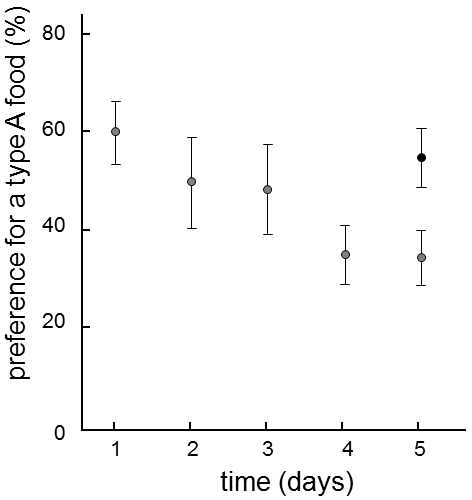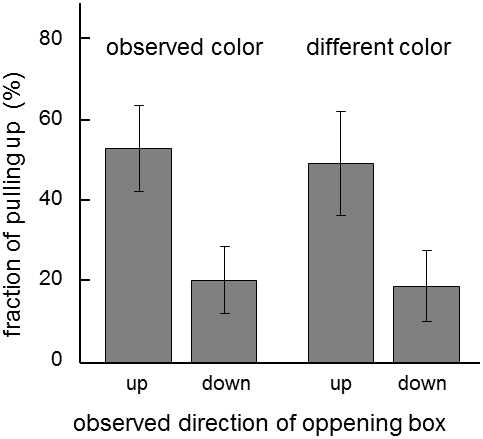XVII.1.2 In cultural evolution, traits are transmitted nongenetically, by learning, most frequently through of imitation
Traits formed in biological evolution are transmitted genetically, most frequently in the form of information written in the primary DNA structure of the relevant species.Simultaneously, in a great many cases, the genetic relatedness of the population is not correlated with the similarity of the patterns of behavior transmitted in the particular group through imitation.For example, in individual populations of chimpanzees monitored for long periods of time in their natural environment, a great many patterns of behavior have been observed that were specific only for the population occurring in a certain territory.Systematic studies have demonstrated that, because of these differences, groups in populations of chimpanzees form a sort of cultural spheres that are strikingly similar to human nationalities.Simultaneously, the similarities of the individual cultures were related only very little to the genetic relatedness of their bearers (Whiten et al. 1999).A similar phenomenon was subsequently observed in orangutans (van Schaik et al. 2003).It is thus apparent that cultural patterns are transmitted to a substantial degree independently of gene flux.
Traits formed as a consequence of cultural evolution are transmitted nongenetically, by social learning, occurring in the simplest case by imitative learning (observational learning), i.e. imitation of the behavior of the individual members of the social group (Fawcett, Skinner, & Goldsmith 2002).If, for example, a rat observes that another rat prefers one kind of food of two possible kinds, then it also prefers this type of food for several days (Galef & Whiskin 2001).Only subsequently can individual experience with the two types of food predominate over the learned patterns of behavior and the animal begins to prefer the actually better type of food (Fig. XVII.2).In humans, imitative

Fig. XVII.2 The effect of social learning on the preference for a type of food in rats. In the experiment, the individual rats were placed together with a rat that ate food A for 30 minutes and were watched for the following four days to see how much they preferred that kind of food. In control rats, which were not influenced in any way in their choice of food, food type A formed only 36% of their total food intake. The graph shows that, on the first day of the experiment, the rats preferred food A; however, during the subsequent days the preference for this type of food gradually decreased to the value typical for the unaffected rats (grey points). However, if another group of rats was not allowed to have its own experience with food type A during the first four days and food A was offered to them on the fifth day, they again preferred food A (black point). This indicates that simple forgetting is not responsible for the decrease in the socially learned pattern of behavior, but that this is affected by individual experience with both types of food. The graph depicts the average values and mean errors in the average for 12 rats. According to Galef and Whiskin (2001).
learning is the most important mechanism of cultural evolution and, according to some authors, it was its development that triggered and facilitated the rapid evolution of our species (Blackmore 2001).However, in most species, social learning does not have the character of imitating the behavior of another individual.Very frequently, the “imitated” individual only draws attention to the possibility of attaining a certain source through its behavior and the “imitating” individual then “finds” a way of getting to this source by itself (Reader & Laland 1999; Blackmore 2001).This mechanism, denoted as stimulus enhancement, is apparently also operative in probably the best known example of cultural evolution, adaptation of English tits to new ways of obtaining food (Hinde & Fischer 1952; Lefebvre 1995).Some time around 1921, blue tits in the Swaythling area learned to peck through the wax closings on milk bottles and peck up the cream from them.The habit gradually spread to other areas of England.Simultaneously, the individual birds used different techniques to open the lids.This indicates that only information on the fact that cream can be obtained by opening a bottle was spread culturally, but not the technique of how to open the bottle (Sherry & Galef 1984; Blackmore 2001).
However, in some species, in addition to stimulus enhancement, imitative learning also plays a role (Fawcett, Skinner, & Goldsmith 2002)(Fig. XVII.3).Imitation of behavior is mostly highly

Fig. XVII.3 Imitative learning in budgerigars. In the experiment, budgerigars (Melopsittacus undulatus) (observers) were allowed to watch how another budgerigar (demonstrator) opened a box containing food. Simultaneously, the box could be opened two ways, by pressing or pulling out one of the two corks, black or blue. In one quarter of the cases, the demonstrator opened the box by pulling out the blue cork, in one quarter of cases by pushing in the blue cork, in one quarter of cases by pulling out the black cork and in one quarter of cases by pushing in the black cork. Then a study was made of the percentage of cases in which the observer opened the box in the same way as shown by the demonstrator at the beginning of the experiment. It is apparent from the graph that the budgies preferentially opened the box in the same way as the demonstrator, without regard as to whether the opened cork had the same color as in the demonstration. According to Heyes and Saggerson (2002).
selective.Young animals very frequentlyimitate their parents or the behavior of other adult members of the population.Another fairly common means of learning consists in imitation of the behavior of the highest-ranking individuals in the social hierarchy.It has been observed, for example for Japanese macaque apes, that if only a low-ranking individual was capable of removing sand from grain (by throwing the mixture into water and collecting the floating grains from the surface), no one tried to imitate it.Only when a dominant male learned this from him did this skill rapidly spread to the whole group (Kawamura 1963).This means of accepting cultural traits is understandably advantageous – from the viewpoint of fitness it makes sense to accept behavior from successful, i.e. from higher ranking individuals.
